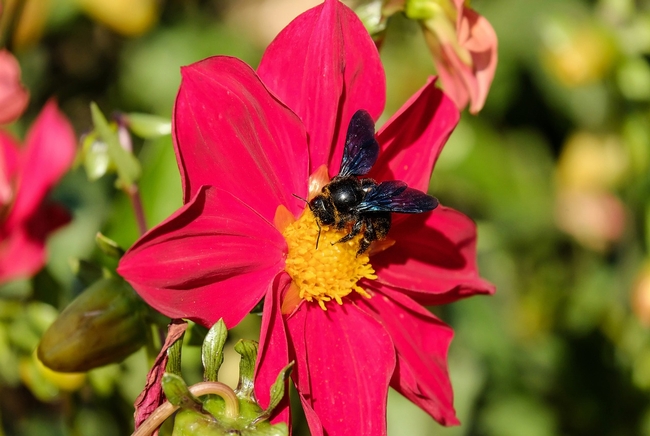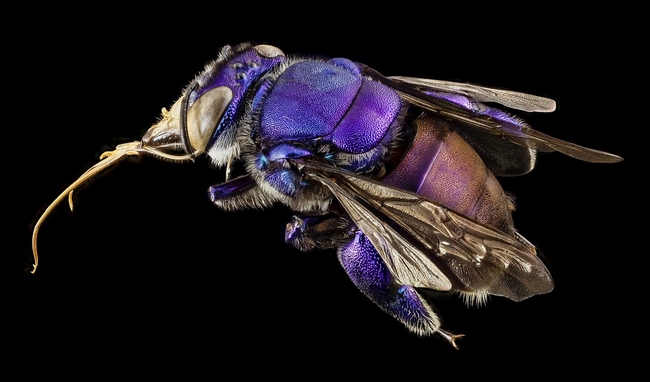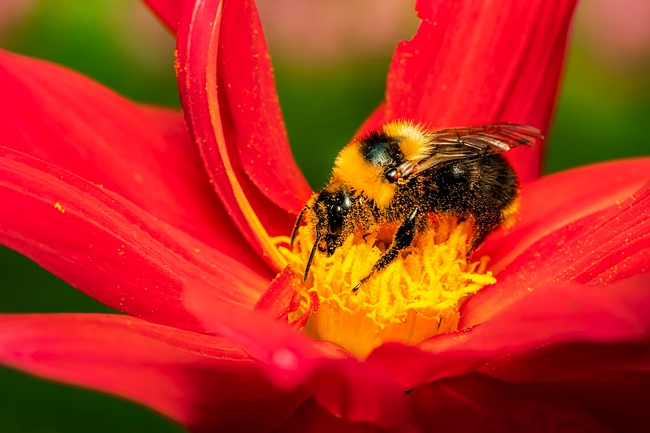One of the pleasures of being a UC Master Gardener is our monthly seminars. Not only are they varied and interesting, but it is always a pleasure when the local members are present. I enjoy being reminded of how smart my colleagues are. A few months ago, Natasha Mantle gave a talk on California native bees. Her presentation was so interesting I was inspired to learn more about our natives, and why they are so important.
The native bee is a more efficient pollinator than the honeybee (which is not native, but a European import). Natives are active in cold or wet conditions. Natives are more thorough pollinators. Their foraging territory is broader, and they are both generalists and specialists in their foraging—some bees seek out particular plants, and others pollinate all plants. They also teach honeybees how to be more effective pollinators.
Natasha told us about ten California native bees. They are mason/blue orchard bee, leafcutter bee, carpenter bee, yellow nosed bumblebee, squash bee, urban digger bee, long horned bee, sweat bee, and ultra green sweat bee.
The leafcutter bee has sharp mandibles so it can chew leaves and construct nests with leaf pulp. Female mason bees build nests in holes in wood. They also use mud to plug the holes in their nests. The blue orchard bee is particularly useful in pollinating almond trees.
The carpenter bee is fascinating to me. Truth to tell, the variety in my yard is so large it is the easiest variety of bee for me to see, as I am nearsighted and not particularly stealthy. I often observe shiny inch-long black carpenter bees with beautiful transparent purple wings crawling over the passionflower and salvia in my yard. They chew on soft wood to form holes for nests. While some eastern carpenter bees may attack the built environment, western varieties prefer to nest in flowering plant stalks, such as agave. The females build the nests, which are complicated structures. Nest tunnels are built with sawdust in a spiral pattern. I haven't found any yet in my yard, but I am still hunting.
Sweat bees are named after one of their attractants, human sweat. They will walk on a person's arm, for example, lapping up sweat, until the host notices (they are quite small) and starts shrieking. Which leads me to stings. Bees do not want to sting you. I have only been stung once in my life, by a bee upon which I stepped, barefoot. Of course, if you are allergic to bee stings, you should be extra cautious anyway in your garden, wearing long sleeves and not running around shoeless.
Squash bees collect pollen from the Cucurbitaceae family, which includes squash and pumpkins. They prefer the pollen from those plants but will collect nectar from anywhere. The females make nests in the ground, but the males will sleep at night in a squash blossom.
Long horned bees are named after the long antennae on the males. The males like to sleep on flowers—you can sometimes see a group of them on a sunflower—while the females prefer to nest in a crack in the ground.
Digger bees are generalists, collecting pollen from native plants as well as other plants such as tomatoes. They, too, nest in the soil.
Bumble bees also nest underground in abandoned animal burrows. Their extremely loud buzz helps them extract pollen from difficult sites. You may ask, “Where are the beehives?”
Only 10% of bee species live in hives. Most bees are solitary and live in already existing structures, such as a hole in the ground. Note: UC Master Gardeners promote mulching, but if you want a good native bee habitat, leave some areas of your yard mulch free.
Natalie gave us some examples of plants that are attractive to native bees: ceanothus, gallardia, Frikart's aster, western redbud, Cascade Creek goldenrod, California poppy, nepeta, Germander sage, Russian sage, and Goodwin Creek lavender. These are perfect for a water-wise garden, too.
A few years ago, there was great concern that bees were dying off. The syndrome was called Colony Collapse Disorder--but it referred to honeybees, not native bees. Scientists studied the causes, which could be pathogens, pesticides or even stress. However, honeybees are a big business, and they are doing well now. It is native bees that are in greater danger, according to Steven Blackledge of Environment America. Natives are losing their habitat, as well as suffering from climate change and a landscape that is loaded with pesticides. Several states have restricted pesticide use, and the 2021 federal infrastructure bill authorized funding to promote pollinator-friendly plants along roadsides. That money has not yet been spent. However, millions of Americans are transforming their yards into pollinator habitats now—a good sign. Pollinator Week 2024 in June 17-24, so maybe you should, too.
Become a Master Gardener Volunteer! UC Master Gardeners of Napa County is now accepting applications for the class of 2025. Visit us at napamg.ucanr/edu to read the informational brochure and register to attend a mandatory information session for applicants. Applications are due September 25, 2024, at 5:00 pm.
Workshop: Join the UC Master Gardeners of Napa County for a workshop on “Get Your Hands Dirty in the Pollinator Garden” on Saturday, June 29, from 10 am to 12 pm, at the Las Flores Community Center, 4300 Linda Vista Ave., Napa.
Workshop: Join the UC Master Gardeners of Napa County for a workshop on “The Succulent /Dry Garden” at the Las Flores Community Center, 4300 Linda Vista Ave., Napa on Saturday, July 27, 2024 from 10 am to 12 pm
Help Desk: The Master Gardener Help Desk is available to answer your garden questions on Mondays and Fridays from 10 am until 1 pm at the University of California Cooperative Extension Office, 1710 Soscol Ave, Suite 4, Napa. Or send your questions to mastergardeers@countyofnapa.org. Include your name, address, phone number, and a brief description.


